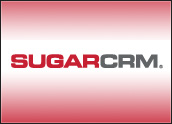
Sugar CRM took its annual customer and partner show on the road this week and brought what had been a Bay Area extravaganza to the Big Apple — the better to attract a sizable population of customers and partners from Europe and other points beyond North America.
It seems to have worked, because even though New York is one of the most cosmopolitan of cities, I heard a lot of European languages in the corridors, and I met many people from countries across the Pacific.
Sugar is a happening thing, at least in part because of all the CRM vendors. It has an innovative business model and a new assertiveness. CEO Larry Augustin tells me the company is growing in the area that is most important to mature and maturing software companies — the enterprise.
According to numbers shared with me, Sugar is growing its enterprise customers at a rate quadrupling last year, and I hope they keep it up. Admittedly, that’s easy to do if you start from a small base, but it still shows growth and validates the strategy.
A Season of Change
Sugar comes to New York after some difficult transitions. The marketing and sales groups were recently restaffed, and I met more than one person who has been in a job or with the company for only a few months.
However, veteran lead guitarist and Sugar returnee Martin Schneider anchors the group. I don’t know Schneider’s official title, but a good approximation might be “keeper of the flame.”
He came to Sugar about five years ago from the 451 Group, an analyst firm where he did some very good work. He stayed at Sugar for those five years, doing more good work, but ultimately went back to 451 — only to return a couple of months ago to help the company through its transition.
It seems reasonable to say that Sugar needed that transition.
The company has been making good numbers with a different business model that included open source, but I think there was also a realization that open source messaging would need some tuning for the enterprise corporate world. The executive team was also obviously looking for new members with the chops to play in the enterprise.
While it’s true that open source has done very well for the industry in areas like the Linux operating system, Apache Server and MySQL database (the core of the LAMP stack along with the PHP and PERL programming languages), open source is also representative of fierce commoditization.
There’s little money to be made in operating systems, server software and databases today. They’ve run their races, and the market has chosen a small handful for standards.
I know I’ll get mail on this, but the issue isn’t how much money any of these items is generating today — Web servers are in the range of US$2 billion, I think — but it’s how much the industries generated in dollar adjusted revenue in their heydays. Commoditization drives a market into a singularity where one vendor does most of the business, and others eventually fail.
Yes, but what about Oracle, Microsoft and IBM in database? True enough, but databases are so embedded that they’re part of the hardware sale. Databases might arguably be less far down the path that operating systems have already traveled.
We could go on, but my point is that CRM is not in the commodity column yet, and probably won’t be for many years. So Sugar’s initial thrust as an open source supplier was at best premature; it might have made sense if you didn’t see social coming.
However, CRM continues to be a jump ball because of all the innovation it spawns. To me, SugarCon is a continuation of an effort to move the company from commodity supplier back to mainstream CRM supplier, and it is largely successful.
Message vs. Reality
In his keynote, Augustin was careful to focus on the things about CRM that keep it from being a commodity; he stressed “every customer, every user, every time.” By this he meant making software that addresses the unique needs of users at all levels. Fair enough, but the messaging felt too reminiscent of days past.
I can’t help but note a small disconnect between the messaging and the reality of the software. The demos show a competent and easy-to-use product set complete with activity streams and social and other inputs. The overall effect, however, is one of automation rather than innovation, and that has become my new yardstick and dividing line (more on that later.)
You have to walk before you run, and I accept that there are a lot of companies out there still learning to walk. By Sugar’s estimate, for every CRM user in existence today, there are a whopping 25 who are not users or who are using some homegrown system cobbled together from old databases and spreadsheets.
I might soon start calling them home-groan.
The existence of so many uninitiated CRMers is plenty of reason to walk back any thought of CRM commoditization, and to focus on helping those customers to walk the CRM walk. That said, however, I think the whole industry has a short fuse burning on getting over the automation-innovation divide.
Some vendors have clearly crossed that chasm, but the majority havenot. You can see it in the demos of SFA that focus on the sales rep serendipitously having a big deal to close. The reality is that sales reps have fifty or a hundred deals to close, and the hard part isn’t getting to the close. The hard part is finding the deals in all the sales data noise that need help in the first place.
They are the deals revealed by analytics as having stayed too long in stage three of a sales process, or the ones that have raced through and tweeted about their imminent need. It takes more than conventional CRM automation to find those deals and to take action on them.
That is where I think CRM is today and where most vendors need to apply elbow grease. Sugar’s special challenge (and you can say this about Sage too) is in communicating this to its partners.
The messaging I heard at SugarCon straddles both worlds, as it must if they expect to educate the partners and bring them along. In many ways, the most important messaging at this event and most important constituents are the partners.
Time to saddle up and ride in a new direction. It will be interesting to see how all this evolves.
























































